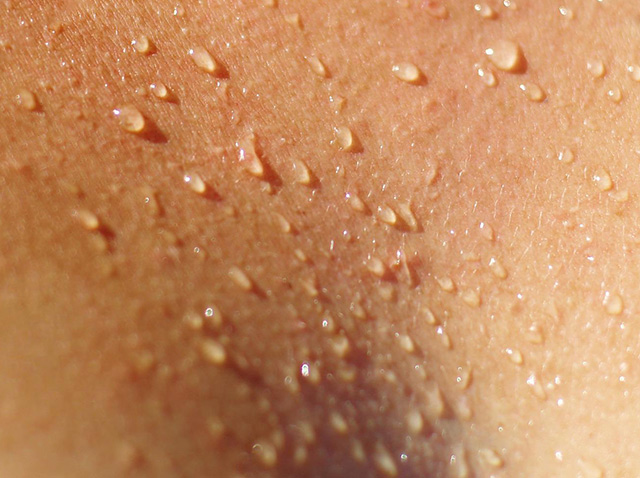Collecting and analyzing sweat has traditionally involved placing skin patches on various sites around the body to collect for later analysis. Another method, as described here, is the whole body-washdown (WBW) method for sweat analysis (Shirreffs & Maughan, 1997).
 sweating skin
sweating skin WBW is considered the 'gold standard' criterion method of sweat collection and analysis, as it is the only way to collect all of the sweat from an athlete’s entire body. However, as it is time-consuming and complex, this method is not commonly used outside of a research setting.
test purpose: collect sweat for electrolyte composition analysis.
equipment required: de-ionised water for pre-cleaning, a solution containing ammonium sulfate for washdown, plastic chamber, cycling exercise equipment, device for electrolyte analysis,
pre-test: Explain the test procedures to the subject. Perform screening of health risks and obtain informed consent. Prepare forms and record basic information such as age, height, body weight, gender and test conditions. See more details of pre-test procedures.
procedure: Weigh the subject (ideally naked), then wash the subject and the equipment with distilled, deionized water and dry with sterile towels. After exercise is completed, the subject and equipment are washed with water containing a marker not present in sweat (ammonium sulfate). All the water is collected at the base of the chamber, from which a sample is taken for analysis.
results: Total sweat loss is calculated from the change in body mass, and the volume of sweat not evaporated is calculated from the dilution of the added marker. The electrolyte composition of the water sample is determined.
advantages: sweat can be collected from the whole body, not relying on estimating overall sweat measurements from samples collected from a range of sites around the body. This method also does not interfere with the normal evaporative sweating process as do patches applied to the skin
disadvantages: it is a complex and time-consuming method, and is difficult to collect sweat during any exercise activity other than stationary cycling.
references:
- Shirreffs, S. M., and R. J. Maughan. Whole body sweat collection in humans: an improved method with preliminary data on electrolyte content. J. Appl. Physiol. 82(1): 336–341, 1997
- Baker LB, Stofan JR, Hamilton AA, Horswill CA. Comparison of regional patch collection vs. whole body washdown for measuring sweat sodium and potassium loss during exercise. J Appl Physiol (1985). 2009 Sep;107(3):887-95.
Similar Tests
- Sweat Monitoring — skin monitors to measure sweat rate and composition.
- Sweat Collection for Analysis — collecting sweat using patches to measure electrolyte composition.
- Sweat Loss Measurement — whole body fluid loss measurement using body weight changes.
- Sweat Rate using patches — measurement of site-specific sweating rate.
- Urine color testing — assessing body hydration by looking at the color of urine.
- Urine specific gravity — using a refractometer to measure the density of a urine sample.
Related Pages
- Sweat Analysis Methods
- Hydration for sport: a collection of articles
- Fitness testing products
- The Future of Fitness Testing — technological advances affecting fitness assessment.
- Technology in Sports
- Measuring dehydration levels


 Current Events
Current Events